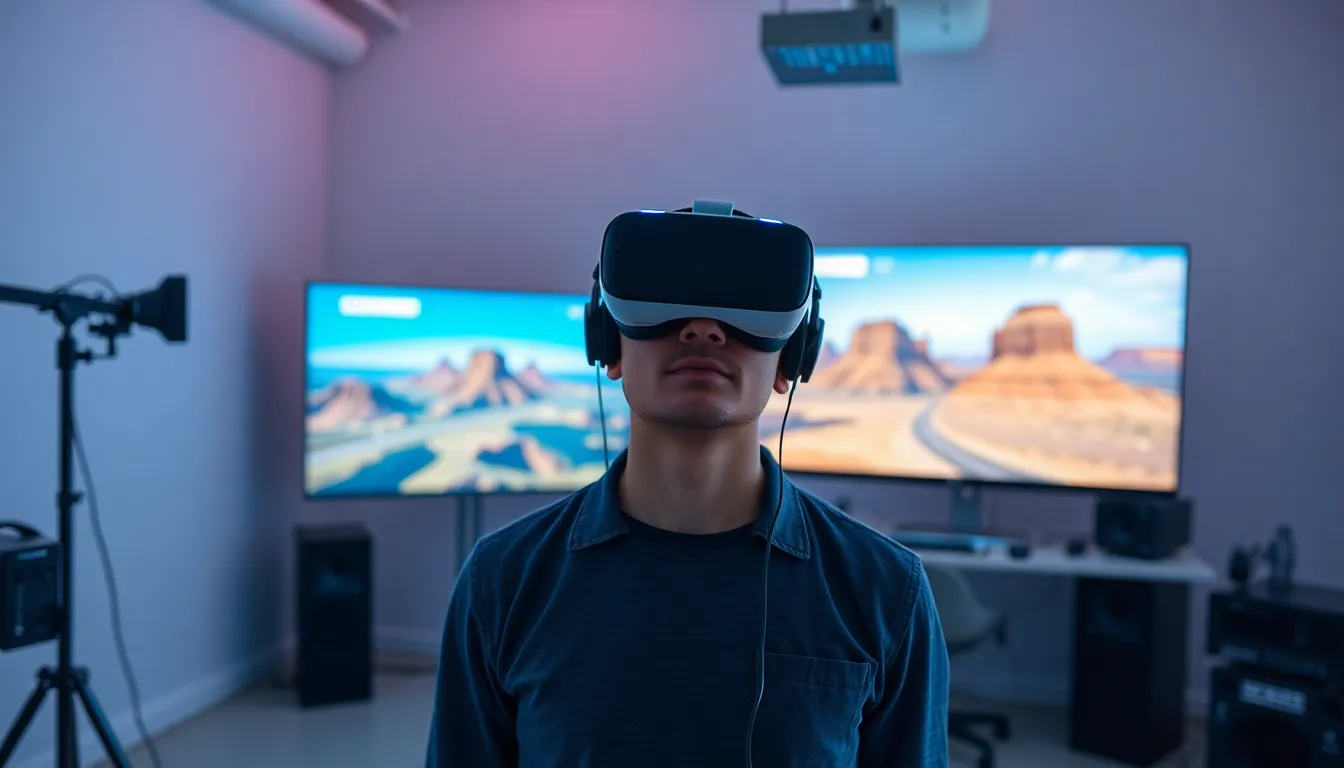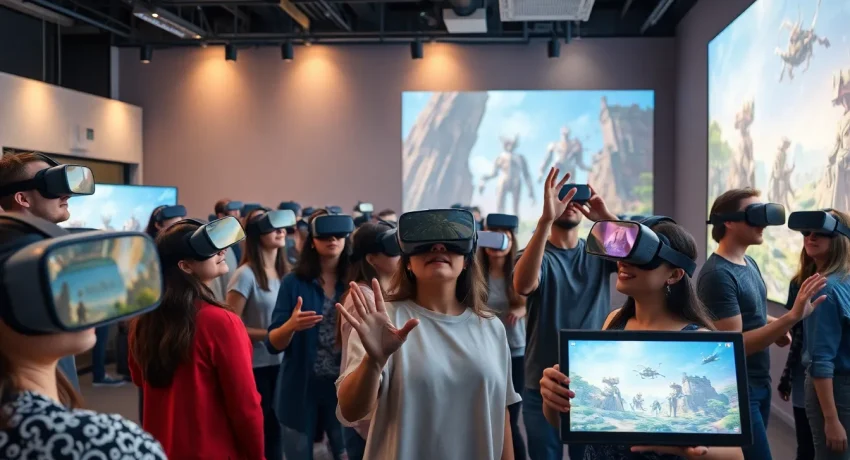Table of Contents
ToggleVirtual reality storytelling is revolutionizing the way narratives are experienced, transporting audiences into immersive worlds where they can interact with characters and environments like never before. This innovative medium combines the art of storytelling with cutting-edge technology, allowing creators to craft experiences that engage multiple senses and evoke powerful emotions.
As VR continues to evolve, it’s reshaping traditional storytelling techniques and offering fresh opportunities for writers, filmmakers, and game developers. By placing viewers at the center of the action, VR storytelling challenges conventional narratives and invites audiences to become active participants in their own adventures. With its potential to create deeper connections and memorable experiences, VR storytelling is poised to redefine the future of entertainment.
What Is VR Storytelling?
VR storytelling refers to the use of virtual reality technology to create immersive narrative experiences. This method integrates interactive elements, allowing audiences to explore stories in dynamic ways. Characters and environments become tangible, offering participants the chance to influence the unfolding narrative.
Key components of VR storytelling include:
- Immersion: Users feel present in the digital environment, heightening emotional engagement.
- Interactivity: Audiences shape the narrative through their choices, fostering personal connections with the characters and plot.
- Sensory Engagement: VR storytelling stimulates multiple senses, creating a visceral experience that enhances storytelling depth.
VR storytelling redefines traditional narratives by inviting users to be active agents in the storytelling process. As technology advances, this form of storytelling continues to expand, offering new avenues for creatives in diverse fields such as writing, filmmaking, and game design.
The Evolution of VR Storytelling

VR storytelling has progressed significantly, transitioning from conceptual ideas to fully realized narratives that engage audiences in immersive experiences. Key developments in technology and experimentation have shaped this evolution.
Early Concepts and Experiments
Early experiments in VR storytelling focused on establishing basic immersive experiences. Projects like “The Invisible Man” and “The Night Cafe” demonstrated the potential of VR as a narrative medium. These experiments utilized simple graphics and interactive elements to engage users. Although limited by technology, they laid the groundwork for future explorations in immersive narratives. Creators began to recognize how spatial storytelling could enhance audience engagement, encouraging deeper emotional connections with characters and plots.
Technological Advancements
Technological advancements significantly influenced the growth of VR storytelling. Innovations such as improved graphics, head-tracking systems, and haptic feedback devices enhanced user experience and immersion. High-definition visuals and realistic sound design fostered a sense of presence in virtual environments. Furthermore, the development of VR platforms like Oculus Rift and HTC Vive made this technology more accessible to creators and consumers alike. These platforms provided tools for storytelling, enabling filmmakers and game developers to create complex narrative structures that adapt to user interactions, thus pushing the boundaries of traditional storytelling methods.
Key Elements of Effective VR Storytelling
Effective VR storytelling hinges on several key elements that enhance engagement and emotional connection with the audience.
Immersion and Engagement
Immersion in VR storytelling creates an environment where users feel fully present in the narrative. High-quality graphics and realistic soundscapes contribute to the sense of reality, making actions and events within the story feel immediate. Spatial audio enhances the experience by allowing sounds to originate from specific directions, mirroring real-world perceptions. With these elements, storytellers draw audiences deeper into the narrative world, encouraging emotional investment and a stronger connection to the characters and plot.
Interactivity and User Agency
Interactivity empowers users to influence the narrative outcome through decision-making. Players can shape their paths, affecting character behavior and storyline progression. This element fosters a sense of agency, making the experience uniquely personal. Storytellers employ branching narratives and responsive environments that adapt to user actions, creating multiple pathways and outcomes. By allowing choices, VR storytelling transforms passive viewers into active participants, heightening engagement and emotional involvement in the story.
Examples of Successful VR Storytelling
Numerous projects exemplify the effectiveness of VR storytelling by merging immersive experiences with compelling narratives. These pioneering efforts underscore the potential of VR to create engaging and interactive stories.
Notable Projects and Experiences
- The Invisible Man: This early VR experience offers a unique perspective on narrative immersion. Users perceive the world from the viewpoint of an invisible character, illustrating the power of spatial storytelling.
- The Night Cafe: Inspired by Vincent van Gogh, this experience lets users explore a virtual recreation of the artist’s iconic café. The project highlights the emotional connection fostered through environment interaction and artistic representation.
- Wolf 359: This episodic audio drama utilizes VR technology to place users in the cockpit of a spaceship. The interactive narrative engages users in a science fiction universe, where their decisions impact story progression.
- Half + Half: A multiplayer VR experience, it combines playful interaction with avoidable tasks to create a light-hearted narrative. Players navigate a vibrant world, emphasizing social engagement and collaboration.
- Boneworks: This game incorporates physics-based interactivity to immerse players in a dynamic environment. The blend of storytelling and gameplay emphasizes user agency, allowing for creative narrative explorations.
Lessons Learned from VR Narratives
- Emotional Engagement: Strong emotional connections flourish when users interact with 3D environments and characters. Successful projects utilize sensory details to evoke feelings, enhancing narrative immersion.
- User Agency: Empowering users to influence outcomes through choices strengthens the narrative experience. The ability to make decisions leads to personalized storytelling, increasing emotional investment.
- Innovative Design: Engaging narratives often incorporate unconventional structures. Projects that embrace non-linear storytelling captivate audiences, inviting exploration of diverse paths.
- Technical Integration: Effective VR experiences depend on the integration of high-quality graphics, audio, and user interfaces. Robust audio-visual elements enhance realism and amplify immersion.
- Community Feedback: Developers can refine narratives through audience interaction and feedback. Collaboration fosters creativity and ensures that stories resonate with diverse audiences, reflecting their needs and preferences.
Challenges and Future Trends
VR storytelling faces several challenges alongside exciting prospects for evolution and growth in the coming years.
Technical Limitations
Technical limitations impact the full realization of VR storytelling potential. Current hardware, while advanced, often requires significant investment, limiting accessibility. High-resolution graphics demand powerful GPUs, which not all users possess. Latency issues can disrupt immersion, creating a disjointed experience. Additionally, the development of compelling content frequently necessitates expertise in both storytelling and technical skills, posing a barrier for less experienced creators. Despite these challenges, ongoing advancements in technology promise enhancements in graphics, processing power, and user interfaces.
Potential for Growth and Innovation
Potential for growth and innovation in VR storytelling remains substantial. As technology continues to advance, creators can explore new narrative formats and interactive paradigms. Integration of artificial intelligence (AI) in storytelling can enable personalized experiences, responding to individual user choices and preferences. As user interfaces improve, creators can craft more intuitive interactions, enhancing user agency. The introduction of location-based VR experiences and social platforms can foster community engagement and collaboration, expanding narratives beyond solitary experiences. Embracing these trends may significantly enrich the storytelling landscape, transforming how audiences connect with narratives and characters.
The evolution of VR storytelling marks a significant shift in how narratives are experienced. This immersive medium invites audiences to step into stories and interact with them like never before. As technology continues to advance, creators have the opportunity to push boundaries and explore innovative narrative formats.
With the blend of emotional engagement and user agency, VR storytelling not only captivates but also transforms viewers into active participants. The future holds immense potential for growth and innovation, promising richer experiences that deepen connections between audiences and stories. As VR becomes more accessible, its impact on storytelling will only grow, reshaping the landscape for creators and audiences alike.




